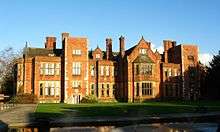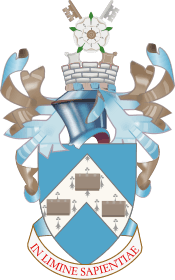Heslington Hall
| Heslington Hall | |
|---|---|
 | |
| General information | |
| Type | Manor house |
| Location | Heslington, York, England |
| Coordinates | 53°56′45″N 1°2′49″W / 53.94583°N 1.04694°WCoordinates: 53°56′45″N 1°2′49″W / 53.94583°N 1.04694°W |
| Construction started | 1568 |
| Client | Sir Thomas Eynns |
| Designations | Grade II* listed |
Heslington Hall is a grade II* listed rebuilt manor house near the village of Heslington, North Yorkshire, England, within the city of York. The hall is located on the campus of the University of York.
The present Victorian building comprises a central nine bay two-storey block with attics and two two-storey wings at each end. It is built of brick in English bond with sandstone ashlar dressings.
History
The original Manor house was constructed in 1568 for Sir Thomas Eynns, the Secretary and Keeper of the Seal to the Council of the North; and his wife Elizabeth.[1] Eynns died in 1573 and the estate were sold in 1601 by his nephews to the Hesketh family. On the death of Thomas Hesketh in 1708, the Hall passed by marriage to the Yarburgh family, who lived in it for several generations.[1] In 1719 Henrietta Yarburgh, 26, married playwright Sir John Vanbrugh at St. Lawrence Parish Church (then the parish church of half of Heslington, including the Hall). The tombs of several members of the Hesketh and Yarburgh families can be seen in the churchyard of St Lawrence. Major Nicholas Yarburgh, who lived at the hall from 1825 to 1852 and was High Sheriff of Yorkshire for 1836, won the St Leger Stakes in 1839 with his horse Charles the Twelfth - one of the local pubs was subsequently named after him.[2]
On the death of Nicholas in 1852, ownership passed to his nephew Yarburgh Greame of Sewerby Hall, Bridlington, who adopted the surname Yarburgh and commissioned architect Philip Charles Hardwick in 1854 to rebuild the hall in the Victorian style. Parts of the original manor house which were preserved include two staircase towers, the courtyard and the pendant stucco ceiling of the great hall. The house was inherited on his death in 1856 by his own nephew, George John Lloyd (who then added the name Yarburgh) and in 1875 by George's daughter, Mary Elizabeth Yarburgh.[1] She had married George William Bateson in 1862 and he then assumed in 1876 the additional surname of de Yarburgh by Royal licence.[1] He later became the 2nd Baron Deramore after the death of his brother in 1890.[1] His two sons, Robert Wilfred de Yarburgh-Bateson (3rd Baron Deramore) (1865–1936) and George Nicholas de Yarburgh-Bateson (4th Baron Deramore) (1870–1943), occupied the Hall after him.[3]
According to Niklaus Pevsner's Yorkshire: York and the East Riding, (page 463, 1995 edn) most of the interior of the Hall now visible is by York architect Brierley, of 1903. At the outbreak of the Second World War, the house was vacated by the family, allowing it to be taken over by the Royal Air Force as the headquarters of No. 4 Group RAF, part of RAF Bomber Command. The hall was not re-occupied by the family after the war. In 1955 the hall was given Grade II* listed building status.[4] When the University of York was founded (it opened to students in 1963) Sir Bernard Feilden supervised its conversion into the administrative headquarters of the University of York.[1] The Hall and University were at that time in the East Riding of Yorkshire although they are now part of the City of York.
| Other images of Heslington Hall | ||||
|---|---|---|---|---|
|
References
- 1 2 3 4 5 6 "Heslington Hall, Heslington". British Listed Buildings. Retrieved 11 February 2013.
- ↑ Major Yarburgh's brown colt, Charles XII, Winner of the 1839 St. Leger, with William Scott Up
- ↑ Archives hub
- ↑ Historic England. "Details from image database (326185)". Images of England. Retrieved 28 April 2010.
- "Heslington Hall-Introductory notes on the building and its owners". University of York. Retrieved 11 February 2013.


